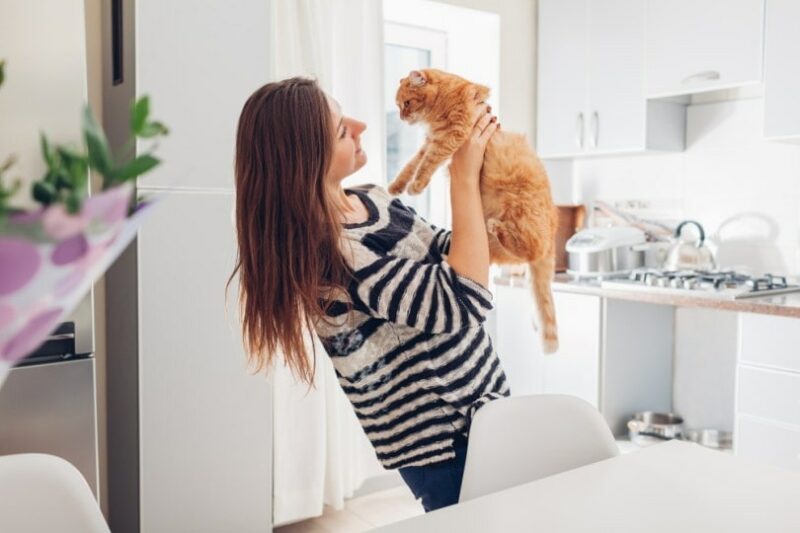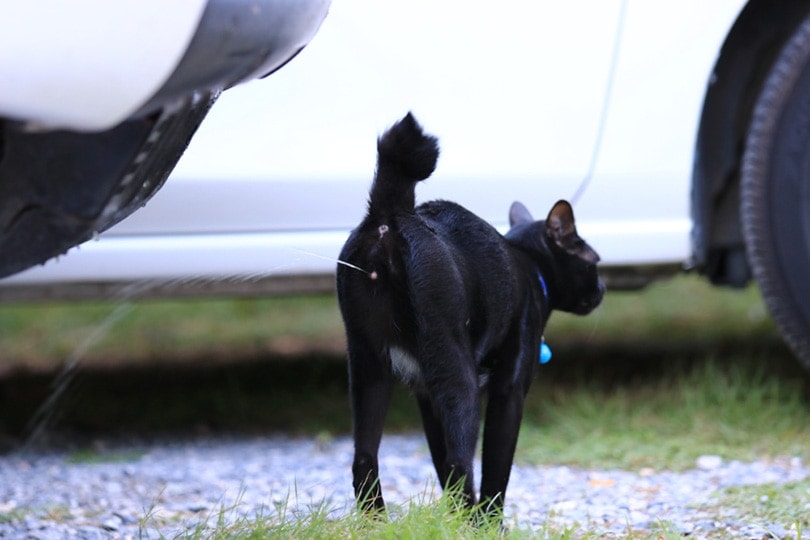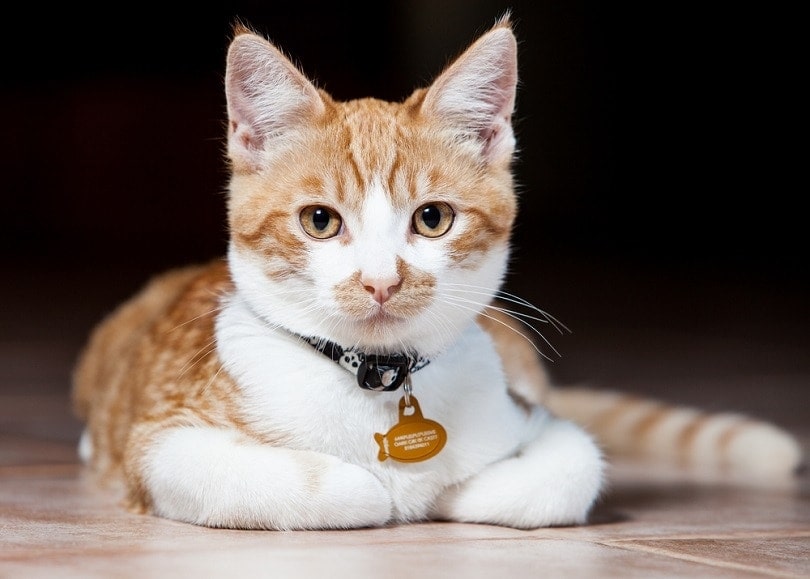Cat Poop Chart: Vet-Approved Color & Consistency Guide
Updated on
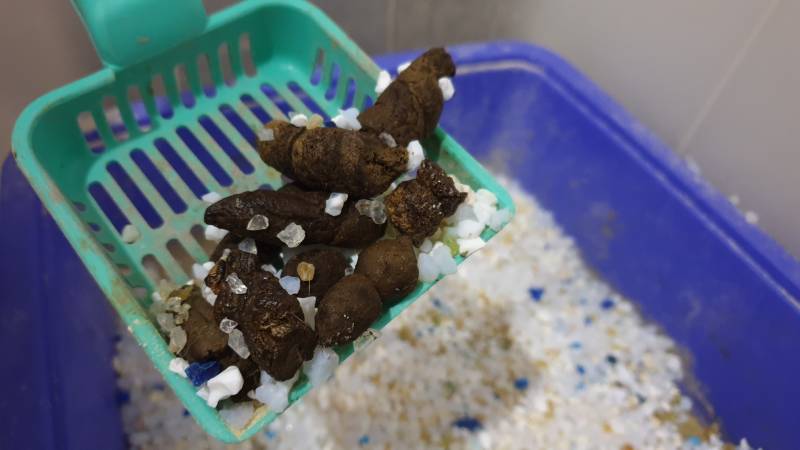
Click to Skip Ahead
Your cat’s poop can tell you a lot about their health and well-being. Most owners who scoop out their cat’s litterbox will be surprisingly aware of their cat’s poop—even if they don’t want to be. Therefore, if something is off, you’ll likely find out.
However, figuring out exactly what’s wrong with your feline based on the color of their poop isn’t easy. You can learn a lot by paying attention to the color and consistency of your cat’s feces. Below, we’ll outline some of the most common inconsistencies in cat feces and what they may mean.
Of course, if you’re questioning your cat’s health, you should contact your veterinarian. While cat poop can tell you a lot, it cannot tell you everything.
Normal Cat Poop
Normal cat poop should be brownish, well-formed, sausage-shaped, easy to scoop, and it shouldn’t smell particularly bad or have an extremely strong odor. The size, consistency, and color will vary slightly from cat to cat, depending on what they’re eating. However, if you scoop out your cat’s litter regularly, you’ll likely notice when the consistency or color changes.
It’s these changes that are important to pay attention to.
Many factors can affect your cat’s normal poop and may not be so normal. However, even a small amount of inconsistency is normal for most cats, as their daily diet, activity level, and hydration will vary slightly. Here are some “normal” changes you can expect to see:
- Diet: If you change your cat’s diet, you should expect their feces to change. This change could be in relation to the consistency, the color, and the frequency of defecation. For example, high-fiber foods can make the poop bulkier, while cats fed a raw meat-based diet will produce smaller and less frequent feces. If you switch your cat’s diet too quickly, you may notice some changes in their poop, usually softer feces. This can be avoided by doing a very gradual transition over 10 to 14 days.
- Hydration: If your cat drinks too much or too little, it will also affect their poop. If your cat is well-hydrated, their poop will be “shiny” and feel humid. If your cat is dehydrated, their poop will be harder, darker, smaller, and drier. If you notice any change to your cat’s drinking habits, their poo can give you plenty of useful information. In fact, these types of changes in your cat’s poop are considered an early sign of dehydration.
- Activity: If your cat becomes more or less active, you can expect their stool to change slightly, too. Exercise stimulates the digestive system, so if your cat becomes suddenly inactive, you may expect signs of constipation, smaller feces, or fewer visits to the litter box.
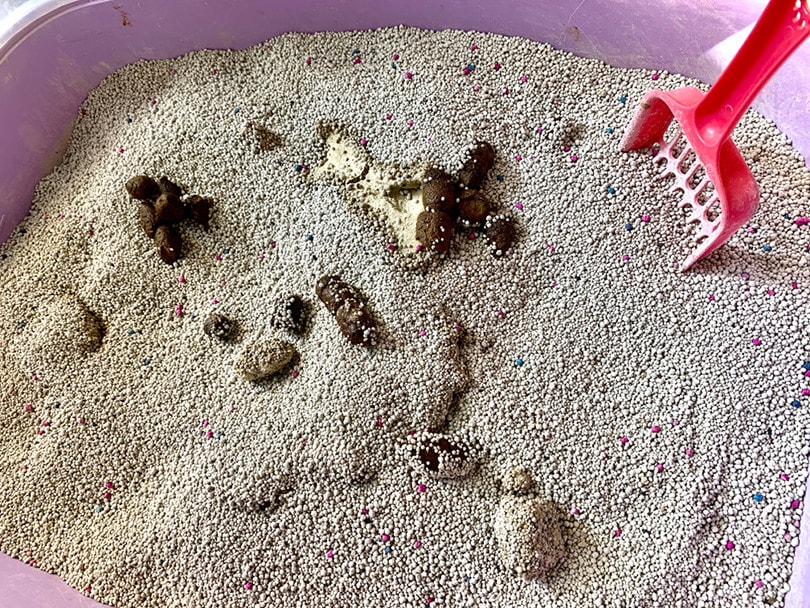
Abnormal Cat Poop
If you notice any changes in your cat’s poop, it may indicate a health problem. Monitoring your cat’s poop isn’t challenging (as long as they have indoor toileting habits) but requires paying attention. Here are some of the factors you should keep up with:
- Color: Cat poop should be brown, either darker or lighter, but brown. If it is a different color, then it probably indicates a problem. For example, red or black poop can indicate bleeding in the digestive tract; green poop can indicate gastroenteritis, infection, liver, or gallbladder issues; orange or yellow poop can indicate gallbladder or liver issue due to excess of bile in the stool or bacterial overgrowth. If your cat eats the same diet consistently, their poop should not change its color, so this isn’t something you should ignore.
- Consistency: A cat’s poop should be solid but not exceptionally hard, dry, or crumbly. Constipation and dehydration usually cause hard or smaller poops. On the other hand, diarrhea can indicate sudden diet changes, food intolerance, stress, parasites, or infection.
- Shape: The shape of your cat’s poop also matters. For example, thin or ribbon-like poop can indicate a blockage or narrowing in the colon, while small or pellet-like poop can indicate dehydration or constipation.
- Smell: Poop is smelly; we all know that. However, cat poop shouldn’t be excessively smelly. If it is, it may indicate an underlying problem. If your cat’s poop has a strong or unusual odor that persists over a few days, check with your vet for possible causes.
After keeping up with these changes, you may be able to determine exactly what may be up with your cat’s health.
| Appearance | Smell | Possible Meaning |
| Brown, firm, cylindrical | Mild | Normal |
| Red, soft, irregular shape | Foul | Bleeding in the lower digestive tract |
| Black, sticky, tarry | Foul | Bleeding in the upper digestive tract |
| Yellow or orange, watery or lumpy | Foul | Liver or gallbladder problems |
| Green, mucoid, or slimy | Foul | Infection, inflammation, liver or gallbladder problems |
| White, crumbly, or chalky | Mild | Raw diet, lack of bile or fat absorption |
| Gray, greasy, or oily | Foul | Pancreatic problems |
If you notice any abnormal signs in your cat’s poop, don’t panic. Some changes may be temporary or harmless, while others require medical attention. The best thing to do is to contact your vet and describe what you see. Your vet may ask you to bring a sample of your cat’s poop for testing and diagnosis.
Depending on the cause and severity of the problem, your vet may prescribe medication, dietary changes, supplements, fluids, or surgery to treat your cat.
Can Cat Food Change Poop Color?
Cat food doesn’t typically change poop color. Normal cat poop is typically brown, though the shade can vary. However, cat food may change a cat’s stool color in specific circumstances.
For instance, if your cat isn’t used to consuming much fiber, high-fiber food can make their poop lighter and bulkier. At the same time, a high-protein food can make it darker; however, these will still be in the “brown” spectrum.
Food dyes in your cat’s main meal or treats can directly affect your cat’s stool color and make your cat’s poop orange, yellow, green, or other strange shades. This isn’t typically a problem, but it can be worrisome for many cat owners. However, if the color change is abrupt or persistent, or if other signs of illness accompany it, it may indicate a health problem, and you should consult your vet.
What Does Mucus in Your Cat Poop Mean?
A small amount of clear mucus coating your cat’s normal-looking poop is generally considered normal. However, mucus mixed with soft feces generally indicates a health problem, usually located in your cat’s large intestine.
Some common issues are colitis (inflammation of the colon) due to internal parasites, infection, or a diet change. If you see a small amount of red blood mixed with the mucus, as alarming as it may seem, it’s very rarely considered an emergency. It indicates inflammation of the large intestine (the last part of your cat’s digestive tract). You should contact your vet and they will do the necessary tests to investigate the reason behind it.
Usually, these illnesses will be accompanied by other signs that your cat is sick. However, cats are notoriously good at hiding their illnesses, so you may not notice that they aren’t feeling well.
For this reason, we highly recommend calling your vet if you’re concerned about your cat’s health. It can be challenging to determine if something is wrong with them without running tests first.
Conclusion
Cat poop can tell you a lot about your cat’s wellness. Cats typically have their own “normal.” Therefore, it’s important to figure out what your cat’s poop normally looks like so that you can notice any abrupt changes. An oddly-colored stool can be a huge issue for many cats, indicating serious health issues, and you should contact your vet about them immediately.
If you do notice that your cat’s stool is strangely colored, take a picture and give your vet a call before scooping out their litter box. Often, the vet will want a stool sample for test purposes. If you already have it on hand, the testing process will go much faster than waiting for your cat to use the litter box again.
See also:
Featured Image Credit: RJ22, Shutterstock



